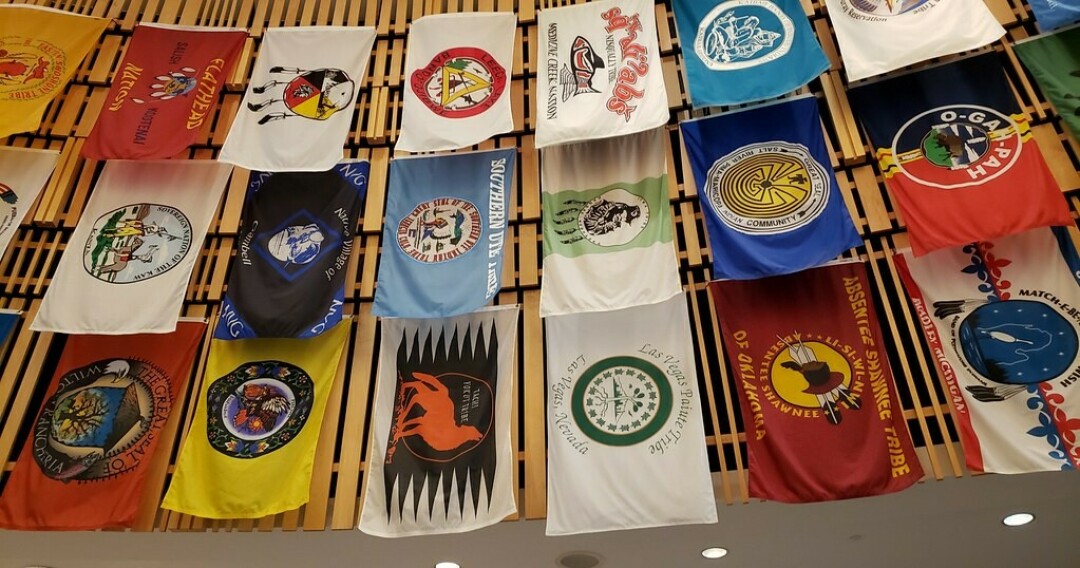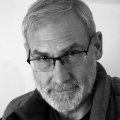News & Articles
Browse all content by date.

A few of the hundreds of tribal flags hung in the Smithsonian’s National Museum of the American Indian.
6th in a series on a visit to Washington DC
Of all the Smithsonians in the Capital, none pulled more firmly on our party than the National Museum of the American Indian.
Constructed with Minnesota’s Kasota stone quarried from the land where 38 Sioux Indians were hung on the Day after Christmas 1862, the curvilinear building looks like the wall of a southwestern canyon. Before their brutal exile, generations of Sioux walked over the stone as it filtered their sky-blue waters.
We walked to the museum along the National Mall on a hot day, taking cover under the shadows of spreading trees. After entering its lofty atrium, our first stop was the museum’s lunchroom. It served Native American fare. We ordered fry-bread tacos with native toppings that would have satisfied a Superbowl party.
The museum celebrates the diversity and future of our many native peoples. Overhead on every floor hang flags representing some 500 tribes, reservations and other divisions of people confined and or removed from their lands for a greater good justified as being for their own good.
One of our grandsons traces back to the Chickasaw and Choctaw. Both tribes were force marched on trails of tears from the Deep South’s rich black soils to enrich eastern bankers and land speculators intent on seizing their land. It would be planted in cotton and tended to by the labor of black slaves.
After starvation, cholera and hundreds of premature graves the "civilized tribes" were resettled in “Indian Territory.” It was a dry and disappointing land but, they were assured, it would be theirs for all time.
The museum shows that despite years of movies with screaming feathered warriors circling wagon trains like ducks at a carnival shooting gallery, native peoples remain. Their languages stubbornly cling to old tongues. Their arts flourish. Their men and now women put their lives on the line for the defense of a nation that is still their home.
From the formation of reservations through my early childhood, native numbers flatlined, but that changed in the Civil Rights Era. In 1970 the Census reported a 66% increase in people with native ancestry while the nation’s population only increased by 13 percent.
Only a people coming out of hiding could explain the jump from 551,000 to 827,000. From 1980 to 1990, native numbers more than doubled from 1,959,000 to 4,100,000 a 110 percent increase. By 2020, 9.7 million Americans claimed Indian ancestry. That was over 17 times more self-reported Native Americans in the last census than in 1960, not long before I moved to the depopulated Sioux lands of southern Minnesota.
Dozens of tribes were sent to Oklahoma with the promise of a forever land but America’s leaders could not help themselves. Land rushes reopened “Indian territory” to new people eager to settle the last bit of frontier.
My great-grandfather McLatchey took his daughter’s favorite horse to the Kansas/Oklahoma line to stake a claim for a new homestead at the sound of a starting gun. He damn near killed the horse only to find the claims were already staked by “Sooners,” whose cheating ways became the beloved nickname for the people of the state. In time the takers forgot.
Famed Oklahoma cowboy-entertainer Will Rogers became America’s favorite prewar humorist. He joked, “I don’t belong to any organized political party. I’m a Democrat.” With a hint of native ancestry he helped the country forget broken promises. After the war another Rogers, composer Richard Rodgers, and his lyricist Oscar Hammerstein added more anesthesia in their sweeping Broadway musical Oklahoma where "the farmer and the cowman" could be friends. Oklahoma’s farmers and cowmen did their best to share in the Osage’s good fortune. The Indian business, they called it.
The Osage, who had been given some of the least promising land, decided to protect what little they had by preventing individual Osage from selling any off. Every Osage owned a “head right.” This was fortuitous because copious deposits of oil were discovered which made the Osage the richest people per capita in the world. In an Oklahoma that had just witnessed the aerial bombardment, looting and burning of Tulsa’s “Black Wall-Street,” this was especially prudent. To many it seemed a terrible shame that all this wealth was wasted on Indians.
But helpful outsiders could marry an Osage and many did. And then the Osage began dying mysteriously in the dozens and maybe the hundreds. Historian David Grann wrote a book about it – Killers of the Flower Moon. In the old days you wouldn’t have seen this story on the big screen.
My grandfather had no use for Hollywood’s treatment of history. Talked into seeing Errol Flynn play General Custer, he told his daughters afterward that Custer should have been court-martialed.
But today’s Hollywood is Native America's friend. Director Martin Scorsese has turned the story into an epic three and a half-hour movie of the same title. He’s done this at a time when Oklahoma’s Republican legislators are trying to protect white children’s feelings by stripping history out of their school books. As our children cut out pilgrims, Indians this Thanksgiving remember the Wampanoag Indians. They numbered perhaps 40,000 souls when the Pilgrims asked for their help. Today they number 3,200 while the descendants of the Pilgrims own Boston’s Beacon Hill.
The federal government belatedly bestowed a reservation upon them in 2015. It's 150 Acres. The City of Duluth, by contrast, has 51,300 Acres.
Welty, a lucky full blooded “white” American can be ignored at lincolndemocrat.com.
| Tweet |


